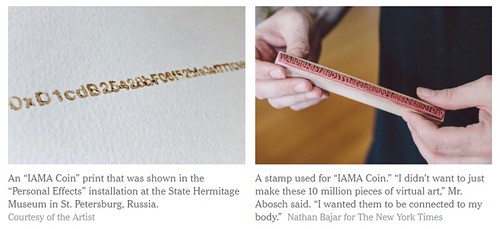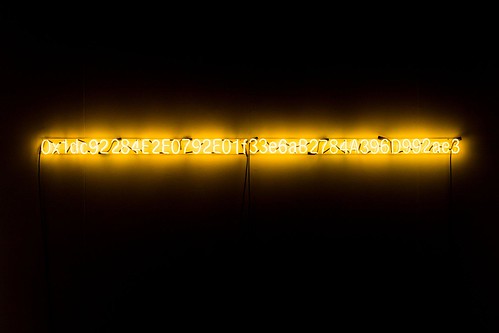
PREV ARTICLE
NEXT ARTICLE
FULL ISSUE
PREV FULL ISSUE
THE MAN WHO WANTED TO BE A COINThe New York Times published a story June 4, 2018 about a conceptual artist exploring cryptocurrencies. -Editor
 Kevin Abosch wanted to turn himself into a coin. Why? Because he sold a photograph of a potato. Let’s back up. Mr. Abosch, 48, is an Irish conceptual artist and photographer who lives in New York. He is also interested in the blockchain, the technology best known for its use in virtual currencies like Bitcoin and ether. The strange culture surrounding these cryptocurrencies is increasingly making its way into art, in works that explore value, decentralization and the buzz around digital money. Which brings us back to “Potato #345,” a photo that made headlines around the world after Mr. Abosch said it was purchased by a European businessman in 2015 for a million euros, or about $1.08 million. On the one hand, the attention generated by the sale was exciting, he said. “On the other hand, the focus shifts from the artistic value to monetary value of the work, and for most artists the art is an extension of the artist, so you yourself start to feel commodified,” Mr. Abosch said. “In order to sort of control that, I began to think of myself as a coin.” Mr. Abosch turned to the blockchain, which essentially records a series of transactions across a large, open network of computers. The Ethereum blockchain allows coders to create virtual tokens, which can be transferred between users. They’re not always currencies, exactly, but something like them. Mr. Abosch created 10 million tokens in January. “But I didn’t want to just make these 10 million pieces of virtual art,” he said. “I wanted them to be connected to my body.” So, he had six vials of his blood drawn. He stamped the contract address — a long string of numbers and letters indicating where the tokens effectively live on the blockchain — onto 100 pieces of paper, in blood. And he called the project “IAMA Coin.” He said he believes that he has “successfully connected my physical body to the virtual works” in such a way that he sees the art “as pieces of me.” Michael Connor, the artistic director of Rhizome, a center affiliated with the New Museum that aims to foster “digital-born art and culture,” said that he’s seen a flurry of crypto-related projects in the past year. “You meet people in the crypto world who throw millions into coins backed by nothing, but don’t understand how a piece of art has any value,” he said. “Then you meet people in the art world who don’t understand why you would invest money in art that has no physical manifestation. That’s where it gets exciting for me.”  “YELLOW LAMBO” (2018), a neon sculpture of a blockchain address symbolizing Lamborghinis, sold to a former Skype executive for $400,000. Maybe my old friend J.S.G. Boggs died too soon - he would be right at home in this world. His performance art explored the nature of money and value, making people think hard about the very concept of
money. -Editor
He has a foot in both the art and tech worlds, and experiments with their intersection; while he works, Mr. Abosch has been wearing an electroencephalogram, or EEG cap, which can measure electrical activity in the brain. He wrote in an email that this is “an attempt to understand to what extent ego is engaged or how it colors work, particularly when I’m photographing humans.” “I think that it’s such a weird field at the moment, so art is evolving really quickly in response to it,” Mr. Connor said. Mr. Abosch, meanwhile, is tokenizing Manhattan. For a soon-to-be-unveiled project, he has created 10,000 blockchain tokens for every street in Manhattan, then printed the contract addresses on a 6-foot-tall map. This month, collectors will be able to buy the tokens, or virtual artworks, for a few dollars each. More projects are on the way. “Whatever this is,” Mr. Abosch said, “I’m right in the middle of it.” To read the complete article, see: Wayne Homren, Editor The Numismatic Bibliomania Society is a non-profit organization promoting numismatic literature. See our web site at coinbooks.org. To submit items for publication in The E-Sylum, write to the Editor at this address: whomren@gmail.com To subscribe go to: https://my.binhost.com/lists/listinfo/esylum All Rights Reserved. NBS Home Page Contact the NBS webmaster 
|